HTC Droid Incredible 4G LTE Review: One Alternative
by Jason Inofuentes on July 13, 2012 9:24 PM EST- Posted in
- Smartphones
- HTC
- Droid
- Mobile
The mobile SoC space is generational, just as the x86 space has been for ages. The ARM Cortex-A9 generation is still with us, with Cortex-A15 SoCs not expected to make their way to devices until 2013. But Qualcomm’s bespoke A15 competitor, Krait, is already with us, and the easy choice for top of the line handsets, particularly in the carrier driven US market. But this isn’t a top of the line handset, so Verizon ordered up the Incredible 4G clocked at 1.2 GHz instead of the S4’s full 1.5 GHz. So what does an underclocked S4 net you?
We’ll start with our more CPU intensive tests.
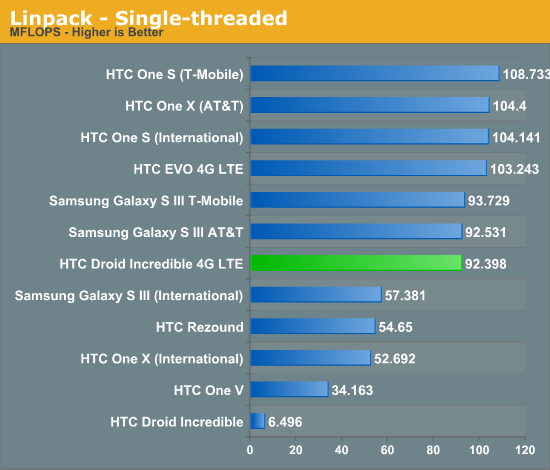
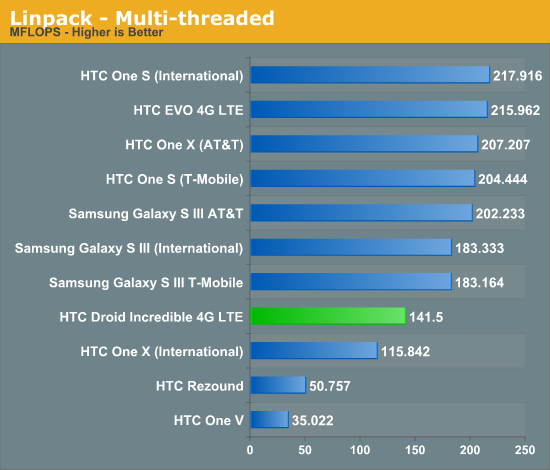
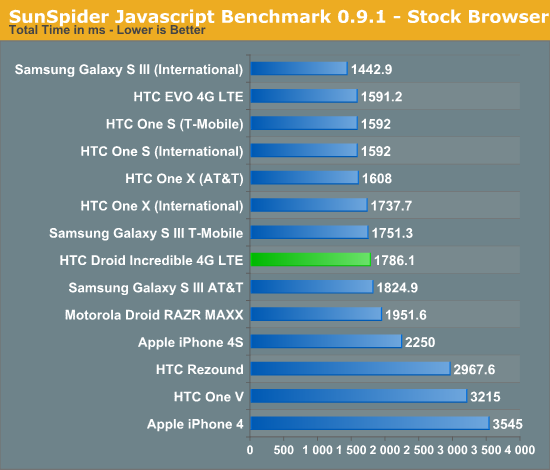
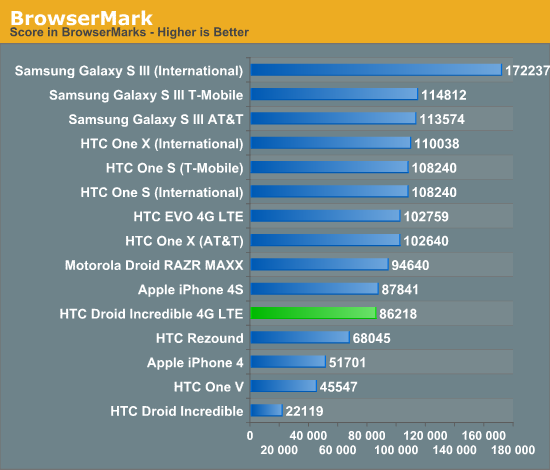
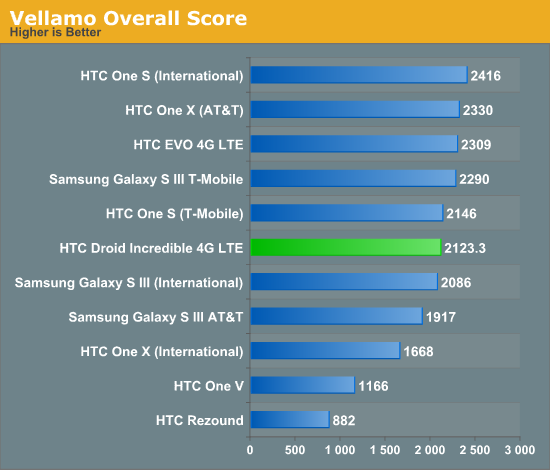
There’s a clear performance deficit relative to the other S4 devices on the market, though the S4 still outperforms many of the devices in our chart. The deficits are worst in the Linpack tests, though it’s unclear why they should exceed the 20% clock deficit. Rendering tests are within the expected deficit, though. What about GPU performance?
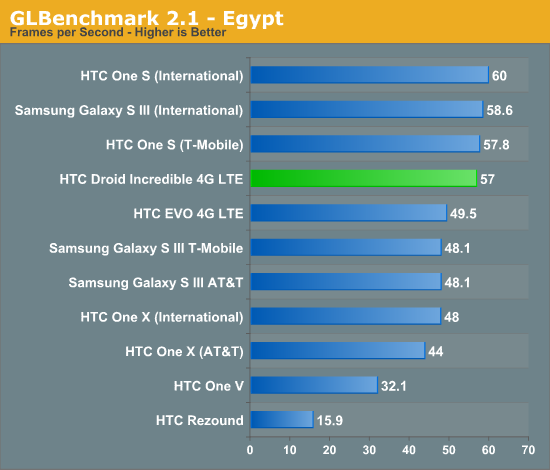
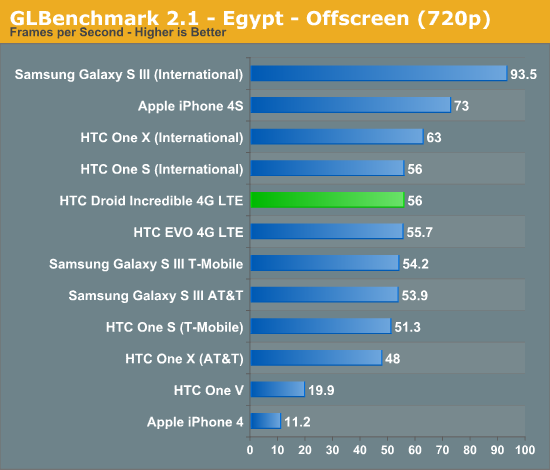
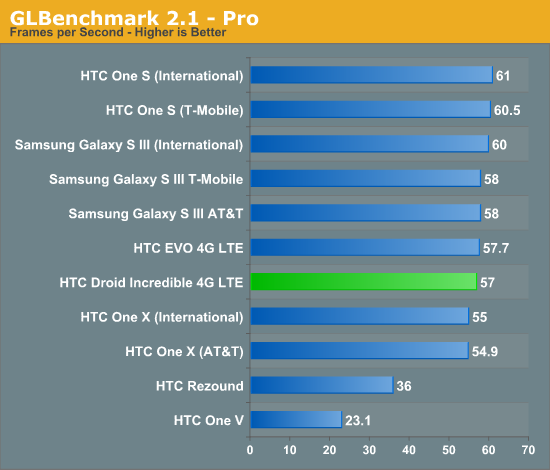
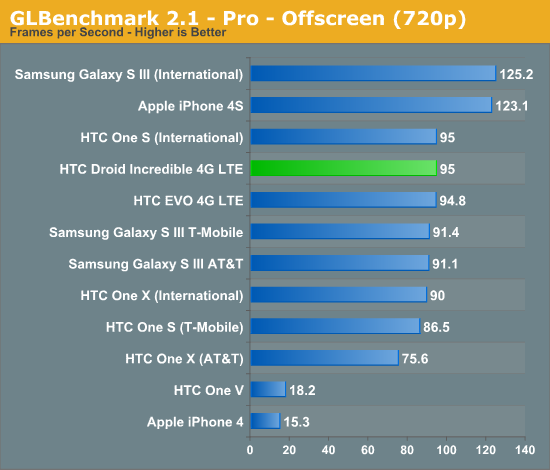
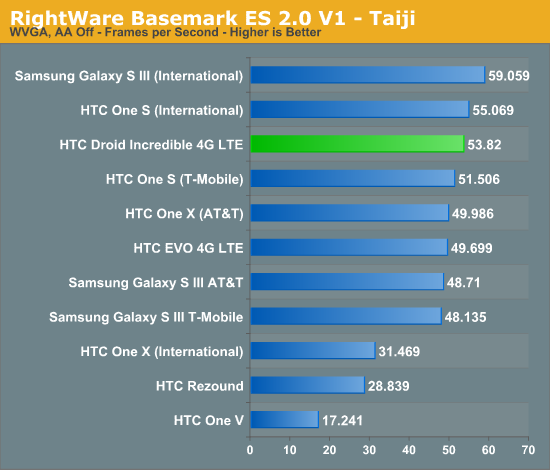
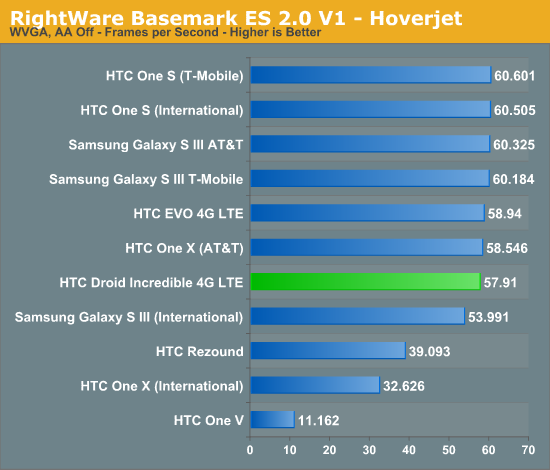
Our GPU tests are starting to show their age, with Vsync getting pegged for the duration of several of them. Even in the challenging offscreen GLBenchmark Egypt test we still see performance approaching 60 fps. Basemark’s Taiji and HoverJet tests typically favor Adreno GPUs, and this is no exception. So, while Rightware’s tests don’t help us stratify the Incredible 4G LTE against non-S4 handsets, it does clue us into something else. With performance that falls in line with the other S4 handsets, but below Vsync in Taiji, it’s almost certain that the GPU didn’t suffer the same clock penalty as the CPU.
All this aside, there’s still the core issue of Ice Cream Sandwich’s UI performance. With the Galaxy Nexus running worlds more smoothly with Jelly Bean, despite last-gen internals, there’s something very compelling about it. Certainly Jelly Bean should have the potential to be just as smooth on other hardware when the update gets distributed, but with Verizon the eternal question is when that update will actually be distributed. For now, though, this is no better or worse than any other Android handset with similar internals. The UI is buttery smooth across home screens, but open up the gallery or app switcher and the lag isn’t just perceivable, it’s a nuisance.










24 Comments
View All Comments
aNYthing24 - Tuesday, July 24, 2012 - link
The One S has a Super AMOLED display, not a Super LCD.Omega215D - Tuesday, July 24, 2012 - link
Kind of strange how battery life differs from other reviews. So far only a couple have said subpar life while more have gotten good to very good usage time. Could it be a problem with the phone itself? Well, it's nice to know my Rezound isn't too bad but I do like the designs of both the Incredible and Rezound.pikahatonjon - Tuesday, July 24, 2012 - link
what is with the differences with the EVO 4G LTE & the Htc One X (att) in the contrast test.also, is the Tmobile Galaxy S 3 actually brighter than the At&t galaxy s 3. arent the 4 phones listed above pretty much identical to each other( one series & galaxy s series) what is with the huge diference in the brightness/contrast test
Rockmandash12 - Tuesday, July 24, 2012 - link
The One X has a Super LCD 2 display, not a TFT display.JimmiG - Tuesday, July 24, 2012 - link
How many more years until Android phones can match the iPhone 4S in terms of 3G web browsing battery life?The Nexus One got 3.77 hours back in 2010 vs 4.5 hours for the iPhone 3G. Fast forward to 2012, and the iPhone 4S has more than doubled the battery life to 9.85 hours, while most Android devices have just barely caught up with the iPhone 3G.
Clearly Apple uses the same batteries as everyone else, so it must come down to incredibly lazy programming and poor power use optimization on the Android side. Some OEMs have apparently taken it in their own hands to optimize battery usage (Samsung, HTC), but this should really be something provided by the core Android OS. Battery life should be the main focus on for the next version of Android!
zorxd - Tuesday, July 24, 2012 - link
The iPhone has a small display. It consume a lot less. AMOLED displays are also not very efficient for displaying white backgrounds found on many web sites.Android's battery life isn't bad. Just look at the cellular talk time.
lunarx3dfx - Tuesday, July 24, 2012 - link
What zorx said. You can't compare the iPhone and most Android phones Apples to Apples because of design differences. I'd be willing to bet money that if you had identical devices, the only difference being that one has an A5 and one has an S4, the S4 would wipe the floor with the A5 in every category except for maybe GPU performance.Not only is the S4 almost certainly more energy efficient due to be being a newer architecture, but it will also smoke it in terms of performance per watt.
A5= Dual Cortex A9's @ 800 MHz
S4= Dual Krait Snapdragons @ 1.5 GHz
On top of clock speed Krait is the ONLY ARM based CPU on the market with out of order execution which is why it is faster than Quad Core CPU's (Exynos 4 and Tegra 3).
Jimmi, I would recommend that you learn a bit about how all of this works before you comment again. The iPhone is a good device (although you couldn't pay me to use one), but in terms of theoretical performance it was out-dated before it was ever even announced.
Phasenoise - Tuesday, July 24, 2012 - link
He indicated, as the article states, that the iphone has superior 3g web browsing battery life.So, for him, perhaps picking display or CPU technologies which consume more power is a poor trade off. He doesn't appear to be interested in theoretical performance, just actual real world browsing usage which as we know is generally not Incredibly taxing (pun intended).
lunarx3dfx - Tuesday, July 24, 2012 - link
The reason I brought up performance, was to illustrate my point that Apple doesn't necessarily make a more efficient product as much as they use low power components. I'll admit that I did get a little lost in my own argument. Oops.JimmiG - Tuesday, July 24, 2012 - link
We will see when the next iPhone comes out with a much bigger display and higher clock speeds but still better battery life. The same thing can be seen with Windows vs OSX on laptops with similar specs - Apple simply spends more time optimizing the software side of their mobile devices.It's not limited to just AMOLED displays, and secondly, the CPU should not spend a lot of time at the highest clockspeed and voltage when you're browsing, especially with 3G which should be bandwidth limited. Unless of course the system is poorly optimized.
I'm an Android user myself, and battery life is the Achilles heel of the system. At the end of the day, my Optimus 2X is down to ~15% of battery while coworkers' iPhones last for two days without charging. It was the same with the Nexus One before that.
Just like the unresponsive and choppy user interface, it's important to realize when there's a problem that needs to be fixed.